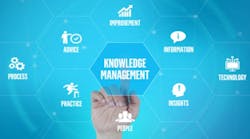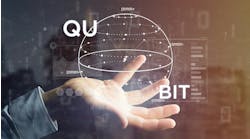Tips for smart knowledge management in the modern industrial workspace
By Tim Kulp is Chief Innovation Officer at Mind Over Machines
According to Microsoft, approximately 40% of workers are considering leaving their employer. The “Great Resignation” is showing no signs of slowing down.
Couple that with the long-predicted mass retirement of the Baby Boomers and the long-standing skilled-labor gap, and it’s clear to see that manufacturing businesses are facing a perfect storm of losing a critical business asset: knowledge.
Knowledge management is a driver of both innovation and performance. Information is crucial to the business, of course, and must be managed well for an organization to function properly. The benefits of an organized knowledge base include solving problems faster, and building better products for customers. But there is a problem—knowledge is often captured in people and when those people leave your organization their knowledge goes with them. And, with nearly one-quarter of all manufacturing workers 55 or older, this has the potential to seriously hurt the industry.
How to build knowledge
The best way to build a knowledge-management practice is to make sure the company's goals and objectives are defined. We must identify why knowledge management matters and educate teams accordingly.
When an industrial employee is asked to explain how they do their job, they begin to wonder if they are being replaced. Be clear and upfront with the purpose of the knowledge-management program. Show people their role and how they can help, then reward those who do.
Many organizations do have a rich knowledge repository in their ERP and CRM systems. The challenge here is that companies cannot convert the data in those knowledge systems into information for action.
Technology to the rescue
Fortunately, technology can help. Where technology was once just the robots on the shop floor or spreadsheets in accounting, we can now carry a super computer in our pocket. As consumers, today’s workforce has been trained to be on-demand thinkers. (Example: I want to listen to Johnny Cash right now, I go to Spotify and search for Johnny Cash). Workforces, too, are experimenting with digital tools that change the world around them, using filters in Tiktok, Instagram and Snap. Many of your workers are using digital assistants like Alexa, Siri, and Google to learn about the weather today or text their spouse to pick up dessert.
Let's examine three knowledge-management technologies that can help an organization retain knowledge:
Internal search engines: A search engine is a very important tool for finding information online. Many companies have internal search engines that are fast and effective at searching through their cloud-based content. Products like G-Suite and Microsoft 365 (formerly Microsoft Office) enable an employee to search content within the enterprise, just like a Google search. Using this, the team can find the instructions for a process, or the quality-control checklist buried somewhere in the intranet. Just like using Google, documents and content can be found with a few words or phrases.
But not so fast—this isn't as easy as described. To achieve discoverability in documents, use proper architecture and metadata on the content so that it will be easier to find. Here's a quick checklist to make content discoverable without needing to be a search engine optimization wizard:
- Title content according to what it actually is. If the document is the 2021 budget, call the document "2021 Budget." Don't use fancy names or long separated file path names like "2021_Budget_Final_Final_Final_v2." Leverage tools like Document Versioning in Microsoft SharePoint to avoid "Final_Final" names.
- Use headings to identify content sections. In Microsoft Word, Google Docs, and other productivity suites, identify section headers using a heading tag. This makes the content identified as relating to a specific topic for readers. Many tools allow for "Outline View" or "Navigation View," which provides an outline view of the document content. This lets users jump to the content that matters.
- Teach employees how to use the productivity tools properly, like Microsoft Office or Salesforce.
Chatbots: This new technology is receiving attention in the field of knowledge management. Instead of having to wade through an overwhelmed search engine, chatbots will go straight for a searched item. For instance, if someone wants to order shoes from an online store, they can ask the bot for shoes, and it will automatically know which sections of the website to recommend.
Chatbots are not only good at helping people find specific content. They also excel at answering questions about the content. For example, if a consumer wants to know shipping costs they can ask the chatbot.
For the team, this means they can have conversations about a topic wiuthout having to dig through piles of search results. Using tools like Google's Dialog Flow, Twilio Bots, or Microsoft Q&A Maker enables an employer to capture instructions and frequently asked questions (FAQs) into a conversation where the user asks a question and the chatbot provides an answer.
Chatbots also allow an employer to view the topics employees are asking, thus allowing for a customized internal learning program. If workers keep asking the chatbot about safety protocols regarding a specific machine, the employer knows they need to provide a course on that machine.
Virtual Reality: Using VR technology with knowledge management can enable those who work in stationary positions, such as data entry or security monitoring, to access information that they need without ever leaving their workstation.
For example, someone who works at a remote facility could use virtual-reality technology to help a machine operator fix a broken machine. The remote team member will be able to see what the operator can see and the remote team can draw directions on the view of the operator.
The Microsoft Dynamics Remote Assist and Vuforia Chalk tools allow teams to come up to speed, quickly, when tasks are assigned. These tools are designed to enable collaboration where more experienced or knowledgeable team members are consulting team members to resolve an issue. Using augmented reality, the team member implementing the change can see what to do overlayed in reality. This allows you to distribute knowledge through a remote workforce and provide hands-on experience in real-time.



